In his latest commentary about recent events in the Russian economy, Sergey Aleksashenko, nonresident senior fellow at the Brookings Institution, analyzes the prospects for economic reform in Russia, implementation of the federal budget, and oil price cycles.
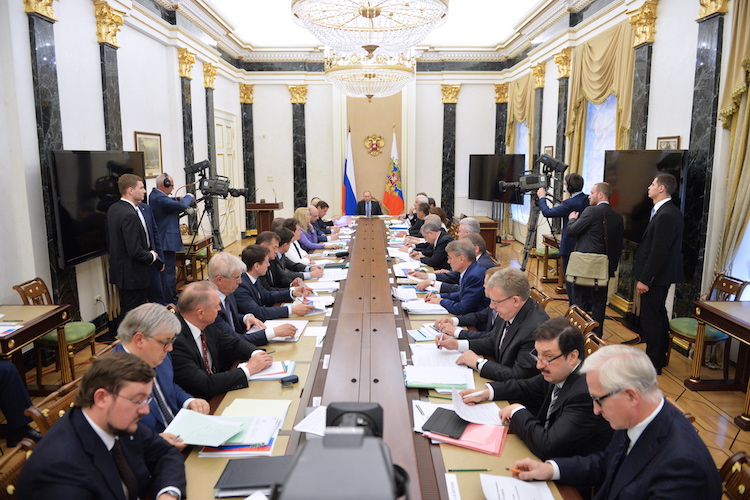
On May 25, at the meeting of the Presidential Economic Council, three scenarios of economic reforms were presented to Vladimir Putin. At it was expected, Putin was in no hurry to make a decision. Photo: Alexey Druzhinin / TASS
The Warrior at the Crossroads
This week Russia’s Economic Council held a meeting at which President Putin was offered a choice of three economic policy scenarios, each of which promises to achieve a 4-percent growth rate. The participants in this beauty pageant included:
- The Economic Development Ministry, which proposes to increase investments at the expense of “the creation of and support for investment resources [as freezing wages is nicely called nowadays], the creation of conditions for the channeling of savings into investments, and the stimulation of investment activity by means of mechanisms of government support”;
- Alexey Kudrin, who proposes to reduce budget expenditures and carry out structural reforms, including judicial reform and the reform of law enforcement agencies;
- The Stolypin Club, which proposes to finance investments by printing money.
In my opinion, the ministry’s proposal is just a continuation of what we have seen over the last five or six years—that is to say, a lot of talk and hope for a stroke of luck, but no real changes at all. In contrast, the other two proposals, were they to be carried out, would inevitably lead to the collapse of the political and economic systems that have been created in Russia. Kudrin’s proposal is aimed at establishing the rule of law, which would lead to political competition and threaten the power hold currently enjoyed by the country’s present rulers. And the Stolypin Club’s proposal would just as inevitably stoke inflation, which would force the authorities to put administrative measures in place on a large scale, imitating the example of Venezuela.
As I was right to bet, no decision was made; the president praised each candidate and suggested to everyone that they think a little longer. After all, we’re talking about what to do after the 2018 elections—in other words, in two years. So why make a decision today?
The Economy Has Not Yet Hit Bottom
Rosstat (the Russian Federal State Statistics Service) has published its estimate of gross domestic product for the first quarter at an unfortunate time indeed. Putin had just declared that, as of last year, the worst of the crisis was behind us, when Rosstat published data revealing that the fall in GDP was continuing, and that in the first quarter a new low had been reached. It should be pointed out, however, that Rosstat’s estimate of the rate of negative growth in the first quarter (-0.6 percent compared to the fourth quarter) is not official: due to a revision of its methodology, Rosstat has altogether stopped publishing data about seasonally adjusted and calendar-year adjusted GDP after 2011.
Chart 1. Dynamics of industrial production in Russia (2012–2016), seasonally and calendar adjusted (100 = January of 2012)
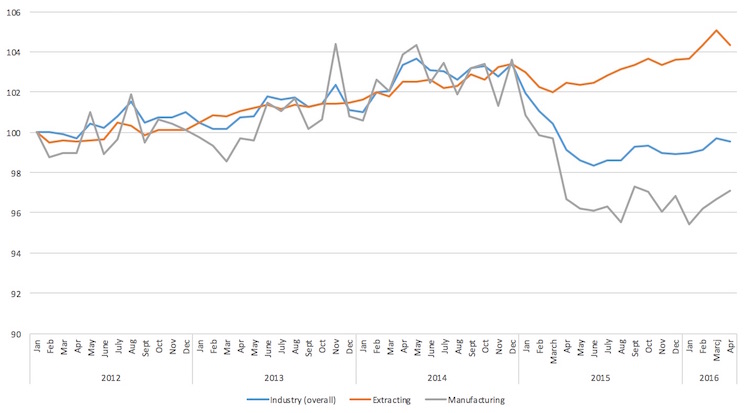
Source: Rosstat; Adjustment: Center for Development
Against this background, the data about the development of industry in April (information for other sectors is not yet available), which reveals continued stagnation, does not look surprising: a steadily growing extractive industry and vigorously growing military-industrial complex (+15 percent in 2014 and +13 percent in 2015) keep the processing industry from bottoming out and ensure that industry shows better results than the economy as a whole.
The Budget Is Doing Very, Very Badly
The Finance Ministry’s accounting for the implementation of the federal budget for April brought no good news whatsoever. The budget deficit for four months comprised 4.7 percent of GDP, which corresponds to what we saw a year ago, with one exception: last year, the Finance Ministry carried out a massive pre-financing of military expenditures in January and February, which distorted all the statistics, but this year nothing of the sort occurred. Something else was observed, however—a sharp drop in income and a limitation of expenses, which offers little hope for favorable year-end results.
In the chart, it is easy to see how rapidly the volume of oil and gas income to the treasury is declining—it’s been cut in half since the end of 2014—and this falloff is only compensated for to a very slight degree by the growth in incomes not related to the extraction and export of hydrocarbons. Overall, income to the treasury for the first four months of the year turned out to be 14 percent lower than it was at the beginning of 2015, and 17.5 percent lower than at the start of 2014.
Chart 2. Income and Expenditure Flow of the Federal Budget, Sliding Three-month Average, 2013–2016 (in Billions of Rubles)
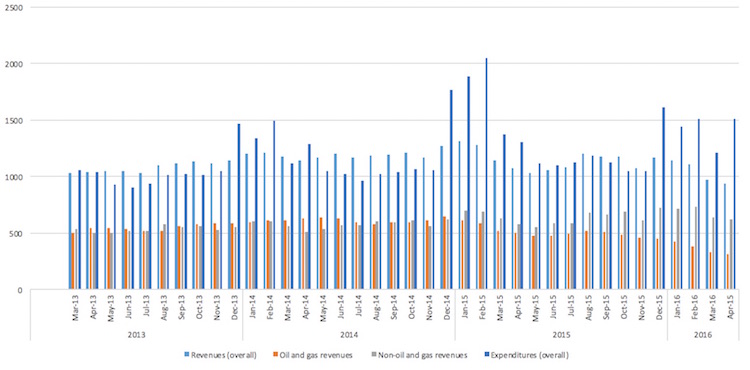
Source: Finance Ministry
This dire income situation pre-determines the difficulties the Finance Ministry is having these days in trying to keep the budget deficit at 3 percent of GDP. The next chart shows that the reduction in income, which accelerated in the second half of last year, resulted in monthly budget expenditures consistently exceeding income. We can only guess at the size of the current deficit, but there is no doubt as to its presence.
Four months into the year, the deficit (in absolute terms) exceeded one half of the annual level, and it seems that in two or three months the Finance Ministry will have to prepare the Kremlin for the necessity of either embarking on a new round of spending cuts (which, as of the first of the year, were at 2014 levels) or agreeing to increase the size of the budget deficit.
Interesting Cycles
Having mentioned the budget and oil prices, I caught myself thinking about how in my professional memory there have already been three cycles of the fall and rise of oil prices (1998–99, 2008–09, and 2014–15), with the current cycle being the fourth. Each of these cycles had its own nature and logic of development, and began and ended with different price levels, and therefore it would be wrong to simply compare them. Nevertheless, I decided to look at them, standardizing the prices—equating the level at the beginning of January of the first year in each two-year cycle to 100. The resulting chart struck me as interesting, and so I’ll share it here.
There are two observations that I would like to point out. First, traditionally the lowest prices occur around January—irrespective of whether OPEC makes a decision about exploitation rate. Obviously, seasonality prevails here, and a price reversal in the middle of winter (including this year) should be accepted as the norm.
Second, the three cycles that have already occurred show us the various scenarios that can play out over two years: a steady price rise, as in 1999; stagnation after a rebound, as in 2009; or a new fall in price, as in 2015. In relation to this, I can only repeat the famous phrase—to predict oil prices is a thankless task.
Chart 3. Variation of Prices for Brent Oil in 1998–99, 2008–09, 2014–15, and 2015–16 (100 = January 1 of the first year in each two-year cycle)
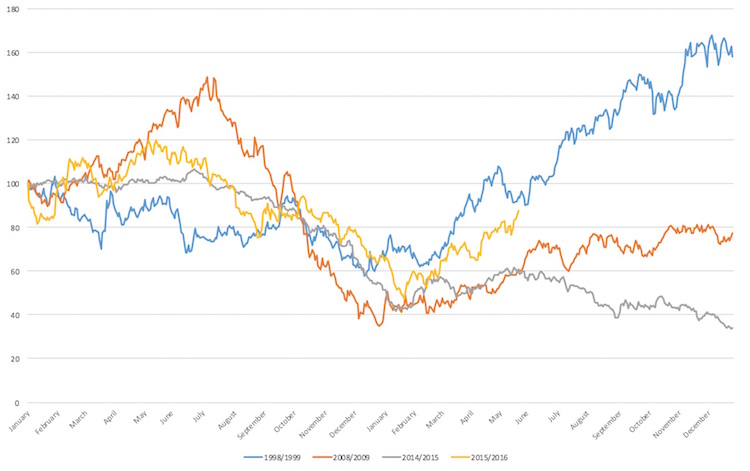
Source: Energy Information Administration
The Minister Saw a Boom
“The mortgage market experienced a real boom in March and April,” economy minister Alexey Ulyukayev declared at the meeting; moreover, he said that a housing recovery had also been observed. I will not address the latter—Rosstat’s summary has not yet been published, although it is certainly possible that the minister has already seen it—but it is worth commenting on the former, the mortgage market.
In previous issues, I called attention to the fact that the volume of mortgage loans granted in January and February noticeably outpaced my expectations, and that from the quantity of mortgage loans issued, the beginning of the current year looked comparable to the beginning of the record year for issuing mortgage loans—2014. Obviously, this trend in no way correlated with statistical data concerning the fall in real incomes of the population, or with data about new automobile sales. Many experts linked this rise in mortgage activity with the uncertainty surrounding the government’s plans to continue or discontinue the program for subsidizing interest rates for mortgage loans. People understandably wanted to get their “piece of the pie.
Now that it’s clear the program will be extended, although at slightly higher rates for borrowers, we will be able to see to what extent this hypothesis was correct. Bank of Russia statistics on quantity of mortgage loans are coming out delayed, and today I have only the data for March in hand. That data indicates that the hypothesis was more than likely sound. In March, the quantity of loans issued went down by 10 percent compared to February, although in normal years (2009–14) the situation was the reverse—the quantity of March credits exceeded February’s level by 15 to 25 percent.
Chart 4. Number of mortgage loans issued in Russia, calculated as a progressive total from the beginning of the year (units)
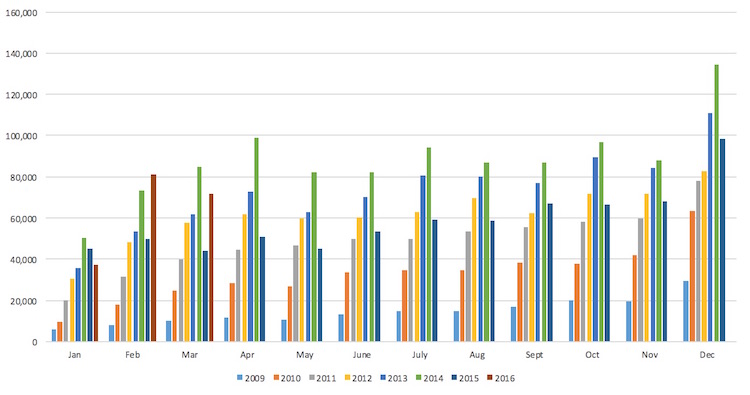
Source: Bank of Russia
Turning Back Ten Years
As I expected, the April data for sales of new passenger cars in Russia brings only bad news—the falloff continues, and at the end of four months, according to Iorg Shreiber, chairman of the committee of automotive producers for the Association of European Business (AEB), the volume of sales has reached its lowest point in ten years.
Chart 5. Sales of passenger cars in Russia, calculated as a cumulative total since the beginning of the year (units)
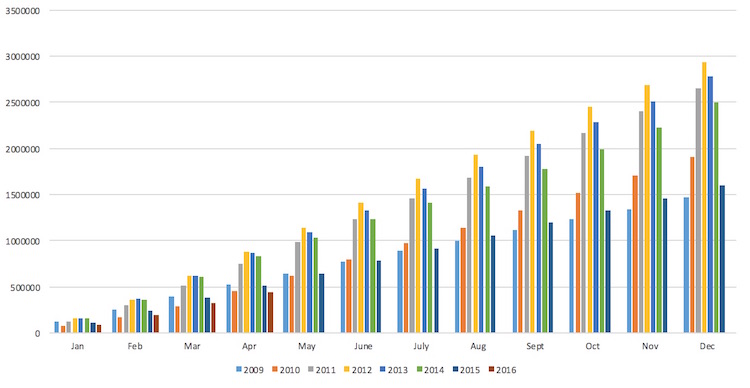
Source: Association of European Business
Secrets of the Bank of Russia
Recently it’s become known that the Bank of Russia has been conducting operations for the sale of government bonds from its portfolio since the beginning of April. In fact, there is nothing strange about this—it’s a standard instrument the Central Bank uses to manage the quantity of money in circulation. The Bank of Russia has been saying for several months that an excess of liquidity has formed in the banking system. Last year, accordingly, the Central Bank reduced the volume of credits issued to banks. But this resource is almost exhausted, and the Bank of Russia has begun to sell government bonds.
So what’s the problem?
The problem is that the Bank of Russia was silent about its operations. That is, it did not provide any information about them at all, even though their volume comprised a bit more than 200 billion rubles over a one-and-a-half-month period, which most assuredly is not a game-changer for monetary policy. I cannot understand the leadership of the Central Bank on this issue—secrecy is the worst weapon in the struggle for confidence.
Hibernation, or Anabiosis
In my view, the latest update from the Bank of Russia about the development of the banking sector in April clearly shows that Russian banks entered a kind of hibernation this year. The majority of indicators show changes occurring within the parameters of several tenths of a percent, and, in the most unpredictable way, the slow growth in a given indicator is giving way to an equally slow decline.
But what do you expect from banks, when the economy doesn’t want to grow?

